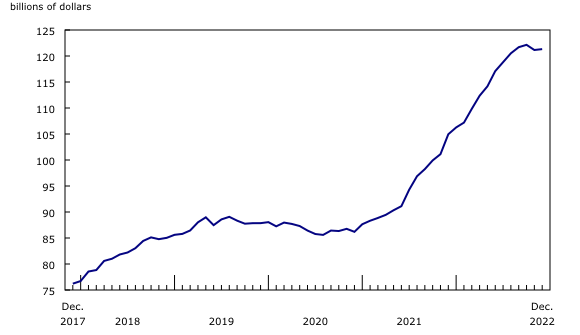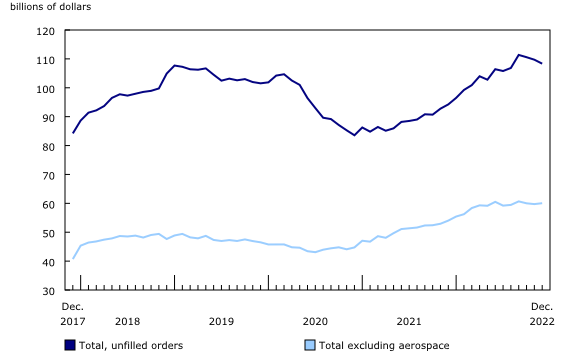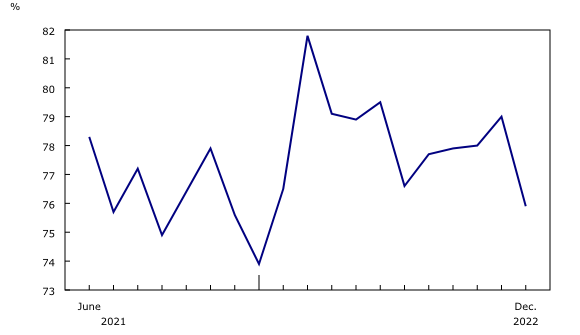Monthly Survey of Manufacturing, December 2022
Archived Content
Information identified as archived is provided for reference, research or recordkeeping purposes. It is not subject to the Government of Canada Web Standards and has not been altered or updated since it was archived. Please "contact us" to request a format other than those available.
Released: 2023-02-15
Manufacturing sales fell 1.5% to $71.0 billion in December, the second consecutive monthly decrease. Sales decreased in 14 of 21 industries in December, led by the petroleum and coal product (-6.4%), wood product (-7.5%), food (-1.5%) and plastics and rubber (-4.0%) industries.
On a quarterly basis, sales increased 1.1% to $215.2 billion in the fourth quarter of 2022, following a 2.1% decrease in the third quarter. The transportation equipment (+3.5%), petroleum and coal product (+2.7%), chemical (+3.6%) and food (+1.6%) industries contributed the most to the increase, while the wood product industry (-7.3%) posted the largest decrease.
On a monthly basis, sales in constant dollars edged down 0.3% in December, while the Industrial Product Price Index fell 1.1% in December. On a quarterly basis, constant dollars sales decreased 0.5% in fourth quarter of 2022.
Petroleum and coal products lead monthly decline
Sales in the petroleum and coal product industry fell 6.4% to $9.6 billion in December, the second consecutive monthly decline. Sales in constant dollars rose 0.9%, indicating that the decline was entirely due to lower prices. Concerns over a possible global recession have contributed to weakening oil prices despite production cuts imposed by OPEC+ and a European Union ban on Russian crude oil. Prices of refined petroleum energy products (including liquid fuels) decreased 10.8% in December, the second consecutive monthly decline, while exports of refined petroleum energy products were down 11.4%. Despite the monthly decline, sales of petroleum and coal products in current dollars were up 27.4% in December on a yearly basis.
After increasing slightly in November, sales in the wood product industry fell 7.5% to $3.3 billion in December, the lowest level since August 2020. Sales in constant dollars fell 3.1% in December, indicating the decline was linked to lower prices and volumes. Prices for softwood lumber fell 8.9%, the fifth consecutive monthly decline, while exports of lumber and other sawmill products declined 12.1%. Higher interest rates in the US coupled with lower construction activities resulted in lower demand for Canadian wood products. Compared with December 2021, sales in current dollars were down 16.9% while on a quarterly basis, sales were down 7.3%.
Sales in the food industry fell 1.5% to $12.0 billion in December, the second consecutive monthly decline. The decrease was largely driven by lower sales in the grain and oilseed milling industry. Prices of grain and oilseed products fell 5.9% in December, while exports of canola declined 16.2%. Sales in constant dollars fell 1.7% in December. Year over year, current dollars sales in the food industry were up 8.4%.
Partly offsetting the declines were increases in the chemical (+3.2%) and aerospace product and parts (+9.4%) industries.
Alberta posts the largest decline
Manufacturing sales declined in eight provinces in December, led by Alberta, British Columbia and Ontario.
In Alberta, sales decreased 5.8% to $8.8 billion in December, almost entirely on lower sales of petroleum and coal products (-16.7%), largely due to a drop in prices. On year-over-year basis, total sales in the province were up 12.1% in December.
In British Columbia, sales fell 3.6% to $5.5 billion in December, mostly attributable to a decline in sales in the wood product industry (-7.5%).
Sales in Ontario decreased 0.5% to $30.9 billion in December, after two consecutive monthly increases, mainly on lower sales in the plastics and rubbers products industry (-13.3%).
Edmonton sales decrease the most
Manufacturing sales fell in 9 of 15 census metropolitan areas in December, led by Edmonton and Quebec.
Sales in Edmonton fell 8.8% to $4.1 billion in December, driven by lower sales of petroleum and coal products (-15.9%).
Following a 3.0% increase in November, sales in Quebec decreased 11.9% to $2.2 billion in December mostly on lower sales in the petroleum and coal product industry.
Inventory levels edges up
Total inventory levels edged up 0.1% to $121.3 billion in December, mainly on higher inventories in the chemical (+4.0%) and electrical equipment, appliance and component (+8.4%) industries. The gains were partly offset by lower inventories in the wood product (-4.2%) and petroleum and coal product (-2.4%) industries.
The inventory-to-sales ratio increased from 1.68 in November to 1.71 in December. This ratio measures the time, in months, that would be required to exhaust inventories if sales were to remain at their current level.
Unfilled orders fall
The total value of unfilled orders decreased 1.2% to $108.3 billion in December, the third consecutive monthly decline. Lower unfilled orders in the transportation equipment (-2.3%), plastics and rubber product (-6.6%) and fabricated metal product (-1.6%) industries contributed the most to the decline.
Capacity utilization rate decreases
The capacity utilization rate (not seasonally adjusted) for the total manufacturing sector decreased from 79.0% in November to 75.9% in December.
The capacity utilization rate fell in 19 of 21 industries in December, notably in the food (-2.5 percentage points), wood product (-11.3 percentage points), and non-metallic mineral product (-11.9 percentage points) industries. These declines were partially offset by an increase in the petroleum and coal product industry (+2.2 percentage points).
Manufacturing: Year in Review 2022
Canadian manufacturing sales and inventories have continued to increase in 2022 in both current and constant dollars. The combination of higher demand for manufactured products after the reopening of economies and persistent supply chain challenges in 2022 impacted several manufacturing industries. Food supply and energy prices were prevalent issues in the year. Additionally, increasing interest rates, semiconductor chip shortages and higher transportation costs also had impacts throughout the year.
Total manufacturing sales in current dollars increased 17.9% to $850.9 billion in 2022, with sales increasing in 20 of 21 industries. The increase was mainly attributed to higher sales in the petroleum and coal product (+60.8%), transportation equipment (+17.8%), food (+11.9%), fabricated metal (+20.4%) and chemical (+13.4%) industries. The wood product industry was the only manufacturing industry that posted a decline in 2022, down 6.6% year over year to $47.7 billion.
Total manufacturing sales in constant dollars increased 4.8% to $622.8 billion in 2022. The increase was mostly due to increases in the transportation equipment (+11.4%) and petroleum and coal product (+8.3%) industries.
At the provincial level, manufacturing sales in current dollars increased in Ontario (+17.8%), Quebec (+15.5%) and Alberta (+27.8%). In Quebec and Alberta, the increase was almost entirely due to higher sales of petroleum and coal product, while in Ontario, higher sales of both petroleum and coal products and motor vehicles drove the increase.
Year-end total inventory levels in 2022 rose 15.6% to $121.3 billion compared with 2021, led by higher inventories in the machinery (+25.0%), transportation equipment (+12.8%), and food (+17.2%) industries. At the same time, inventory levels in constant dollars rose 8.6%. Raw materials experienced the largest increase among the inventory components in both current (+18.3%) and constant (+13.5%) dollars.
Strong growth in current dollar sales led by petroleum and coal product, transportation equipment and food industries
Sales in the petroleum and coal product industry experienced the largest year-over-year increase in 2022, up 60.8% to a record-high $119.1 billion in current dollars. In 2022, the average monthly prices for refined petroleum energy products rose 56.7%, and exports increased 71.0%. Both increased demand and supply issues following the onset of the war in Ukraine contributed to the increase in prices for energy and petroleum products. In constant dollar terms, sales in the petroleum and coal product industry were up 8.3% to $78.8 billion.
Sales in the transportation equipment industry rose 17.8% to $108.9 billion in 2022, mainly as a result of higher sales in the motor vehicles (+22.8%) and motor vehicle parts (+18.8%) industries. Both industries experienced supply chain issues in 2021, operating well below full capacity for most of the year. Although these issues remained prevalent in 2022, global supply chains have started to improve, lessening their impact on auto manufacturers. Despite the growth in current sales and units compared with 2021, Canadian assembly plants sold fewer units in 2022 than in 2020 (-8.3%) and in 2019 (-34.6%).
The third largest year-over-year increase was in the food manufacturing industry, with sales up 11.9% to $141.7 billion in 2022, mostly reflecting higher prices as volume sales were up 1.2%. Higher sales in the grain and oilseed milling and meat product industries contributed the most to the annual growth. Prices were a large cause for the increase in the grain and oilseed products industry which saw, on average, prices increase 24.0% in 2022. Russia and Ukraine were among the top exporters of wheat in the world, and the war in Ukraine has strained global wheat supply, contributing to higher prices.
Additionally, many prices of input products used in the food industry have been driven up, such as the average prices for fertilizers, which rose 50.3% in 2022, and the average prices for animal feed, which increased 16.4%.
Wood industry sales decreased 6.6% in 2022 to $47.7 billion. Volume sales declined 0.3% in the year, while prices for softwood lumber were down by 6.5% in 2022, after gaining 60.3% in 2021 and 38.6% in 2020. The decline in wood prices in 2022 was driven by the decrease in US and Canadian demand for housing, in response to high interest rates in both countries.
Inventory levels continue to rise in 2022
Supply chain disruptions and procurement challenges continued to put inflationary pressures on manufacturing inventories. Year-end inventory levels rose to $121.3 billion in 2022, a 15.6% increase from 2021.
By stages of fabrication, the value of inventories of raw materials (+18.3%), finished products (+14.2%) and good in process (+13.1%) were up compared with 2021.
Meanwhile, total inventory levels in constant dollars experienced an 8.6% increase in 2022 compared with 2021, reflecting higher inventories of raw materials (+13.5%), finished products (+4.8%), and goods in process (+5.7%).
When compared with pre-COVID-19 pandemic year-end inventory levels in 2019, total inventories in current dollars rose 38.1% in 2022, while inventories in constant dollars rose 9.8%.
Share of raw material inventory increases in durable goods industries
Year-end inventory levels in the durable goods industries rose 16.9% from 2021 to $73.9 billion in 2022. At the same time, inventory levels in constant dollars rose 13.4%. The increase in current dollar durable goods inventories was primarily on higher inventory levels in the machinery (+25.0%), transportation equipment (+12.8%), and computer and electronic product (+44.0%) industries.
Inventories of raw materials (+21.0%) posted the largest increase among the durable inventory components, followed by finished goods (+18.3%), and goods in process (+10.6%). The share in total inventories of raw materials has been increasing since the onset of the pandemic in February 2020, while the share of goods in process has declined. Much of the increase in raw materials was driven by volume growths, as raw materials inventories rose 20.1% in constant dollars. Difficulties in acquiring inputs and supplies since the start of the pandemic resulted in manufacturers accumulating more raw material inputs throughout most of 2022 as a hedge against the uncertainty of supply chains.
Inventories in non-durable goods industries driven by higher prices
In the non-durable goods industries, year-end inventory levels rose 13.7% to $47.4 billion, mainly on higher prices, as inventories in constant dollars rose 2.2%.
All three components of inventories in the non-durable goods industries were up, with raw materials increasing 13.7%, finished products increasing 11.2%, and goods in process increasing 22.7%. The current dollar growth in raw materials and finished goods were mainly driven by higher prices as, in constant dollars, raw materials rose 4.8% and finished products declined 2.1%. In contrast, inventories of goods in process were more affected by volume increases (+9.9%).
The food (+17.2%), petroleum and coal product (+26.3%), and chemical (+18.0%) industries were responsible for 91.1% of the growth in total non-durable inventories. These increases were attributed to higher input prices of wheat (+30.2%), ammonia and chemical fertilizers (+50.3%), and crude oil (+47.1%) following the onset of the war in Ukraine.
Sustainable development goals
On January 1, 2016, the world officially began implementing the 2030 Agenda for Sustainable Development—the United Nations' transformative plan of action that addresses urgent global challenges over the following 15 years. The plan is based on 17 specific sustainable development goals.
The Monthly Survey of Manufacturing is an example of how Statistics Canada supports the reporting on the global sustainable development goals. This release will be used to help measure the following goal:

Note to readers
Monthly data in this release are seasonally adjusted and are expressed in current dollars, unless otherwise specified.
Seasonally adjusted data are data that have been modified to eliminate the effect of seasonal and calendar influences to allow for more meaningful comparisons of economic conditions from period to period. For more information on seasonal adjustment, see Seasonally adjusted data – Frequently asked questions.
Trend-cycle estimates are included in selected charts as a complement to the seasonally adjusted series. These data represent a smoothed version of the seasonally adjusted time series and provide information on longer-term movements, including changes in direction underlying the series. For information on trend-cycle data, see Trend-cycle estimates – Frequently asked questions.
Both seasonally adjusted data and trend-cycle estimates are subject to revision as additional observations become available. These revisions could be large and could even lead to a reversal of movement, especially for reference months near the end of the series or during periods of economic disruption.
Non-durable goods industries include food; beverage and tobacco products; textile mills; textile product mills; clothing; leather and allied products; paper; printing and related support activities; petroleum and coal products; chemicals; and plastics and rubber products.
Durable goods industries include wood products; non-metallic mineral products; primary metals; fabricated metal products; machinery; computer and electronic products; electrical equipment, appliances and components; transportation equipment; furniture and related products; and miscellaneous manufacturing.
Production-based industries
For the aerospace and shipbuilding industries, the value of production is used instead of the value of sales of goods manufactured. The value of production is calculated by adjusting monthly sales of goods manufactured by the monthly change in inventories of goods in process and finished products manufactured. The value of production is used because of the extended period of time that it normally takes to manufacture products in these industries.
Unfilled orders are a stock of orders that will contribute to future sales, assuming that the orders are not cancelled.
New orders are those received, whether sold in the current month or not. New orders are measured as the sum of sales for the current month plus the change in unfilled orders from the previous month to the current month.
Manufacturers reporting sales, inventories and unfilled orders in US dollars
Some Canadian manufacturers report sales, inventories and unfilled orders in US dollars. These data are then converted to Canadian dollars as part of the data production cycle.
For sales, based on the assumption that they occur throughout the month, the average monthly exchange rate for the reference month established by the Bank of Canada is used for the conversion. The monthly average exchange rate is available in table 33-10-0163-01. Inventories and unfilled orders are reported at the end of the reference period. For most respondents, the daily average exchange rate on the last working day of the month is used for the conversion of these variables.
However, some manufacturers choose to report their data as of a day other than the last working day of the month. In these instances, the daily average exchange rate on the day selected by the respondent is used. Note that because of exchange rate fluctuations, the daily average exchange rate on the day selected by the respondent can differ from both the exchange rate on the last working day of the month and the monthly average exchange rate. Daily average exchange rate data are available in table 33-10-0036-01.
Revision policy
Each month, the Monthly Survey of Manufacturing releases preliminary data for the reference month and revised data for the previous three months. Revisions are made to reflect new information provided by respondents and updates to administrative data.
Once a year, a revision project is undertaken to revise multiple years of data.
Real-time data tables
Real-time data tables 16-10-0118-01, 16-10-0119-01, 16-10-0014-01 and 16-10-0015-01 will be updated on February 22.
Next release
Data from the Monthly Survey of Manufacturing for January 2023 will be released on March 14, 2023.
Contact information
For more information, or to enquire about the concepts, methods or data quality of this release, contact us (toll-free 1-800-263-1136; 514-283-8300; infostats@statcan.gc.ca) or Media Relations (statcan.mediahotline-ligneinfomedias.statcan@statcan.gc.ca).
- Date modified:








